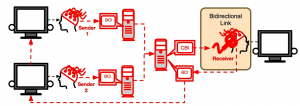Difference between revisions of "Brain-to-Brain Interface"
(Created page with "Brain-to-brain interface is an interface technology that allows for communication between biological brains. These interfaces typically employ the use of a brain-machine inter...") |
(→Recent Work) |
||
| Line 2: | Line 2: | ||
===Recent Work=== | ===Recent Work=== | ||
[[File:BrainNet.png|thumbnail| Description of BrainNet. https://www.nature.com/articles/s41598-019-41895-7/figures/1]] | [[File:BrainNet.png|thumbnail| Description of BrainNet. https://www.nature.com/articles/s41598-019-41895-7/figures/1]] | ||
| − | A brain-to-brain interface between rats was established in 2013. Using a brain-machine-interface, cortical and sensorimotor signals containing information of what lever out of two the encoder rat pressed were recorded, and then that information was transmitted to another rat who had to press the same lever. The receiving rat learned to press the correct lever, denoting the successful establishment of the pathway between the two brains. | + | A brain-to-brain interface between rats was established in 2013.<ref>Pais-Vieira, M., Lebedev, M., Kunicki, C. et al. A Brain-to-Brain Interface for Real-Time Sharing of Sensorimotor Information. Sci Rep 3, 1319 (2013). https://doi.org/10.1038/srep01319/</ref> Using a brain-machine-interface, cortical and sensorimotor signals containing information of what lever out of two the encoder rat pressed were recorded, and then that information was transmitted to another rat who had to press the same lever. The receiving rat learned to press the correct lever, denoting the successful establishment of the pathway between the two brains. |
| − | In 2013, researchers at the University of Washington designed a brain-to-brain interface between humans. Using electroencephalography (EEG) and transcranial magnetic stimulation (TMS), participants of the study played a cooperative computer game while in separate buildings on the campus. The electrical brain activity of one participant was recorded and sent to the other, which then caused motor movement of the hand in the receiving participant to click or move the mouse on the game. | + | In 2013, researchers at the University of Washington designed a brain-to-brain interface between humans.<ref>Rao RP, et al. A direct brain-to-brain interface in humans. PloS One. 2014;9:e111332. doi: 10.1371/journal.pone.0111332./</ref> Using electroencephalography (EEG) and transcranial magnetic stimulation (TMS), participants of the study played a cooperative computer game while in separate buildings on the campus. The electrical brain activity of one participant was recorded and sent to the other, which then caused motor movement of the hand in the receiving participant to click or move the mouse on the game. |
| − | Scientific journal Nature published a study in 2019 of a similar setup as from the University of Washington, in which participants played a game similar to Tetris. Researchers created BrainNet, described as the “first multi-person non-invasive direct brain-to-brain interface for collaborative problem solving.” | + | Scientific journal Nature published a study in 2019 of a similar setup as from the University of Washington, in which participants played a game similar to Tetris. Researchers created BrainNet, described as the “first multi-person non-invasive direct brain-to-brain interface for collaborative problem solving.”<ref>Jiang, L., Stocco, A., Losey, D.M. et al. BrainNet: A Multi-Person Brain-to-Brain Interface for Direct Collaboration Between Brains. Sci Rep 9, 6115 (2019). https://doi.org/10.1038/s41598-019-41895-7/</ref> |
Revision as of 16:58, 12 March 2021
Brain-to-brain interface is an interface technology that allows for communication between biological brains. These interfaces typically employ the use of a brain-machine interface (also called brain-computer interface) to establish connection from one brain to a machine, which then transmits the received neural information to another brain. Brain-to-brain interfaces have been utilized with animals, and recent developments have also begun to successfully implement them for humans.
Recent Work

A brain-to-brain interface between rats was established in 2013.[1] Using a brain-machine-interface, cortical and sensorimotor signals containing information of what lever out of two the encoder rat pressed were recorded, and then that information was transmitted to another rat who had to press the same lever. The receiving rat learned to press the correct lever, denoting the successful establishment of the pathway between the two brains.
In 2013, researchers at the University of Washington designed a brain-to-brain interface between humans.[2] Using electroencephalography (EEG) and transcranial magnetic stimulation (TMS), participants of the study played a cooperative computer game while in separate buildings on the campus. The electrical brain activity of one participant was recorded and sent to the other, which then caused motor movement of the hand in the receiving participant to click or move the mouse on the game.
Scientific journal Nature published a study in 2019 of a similar setup as from the University of Washington, in which participants played a game similar to Tetris. Researchers created BrainNet, described as the “first multi-person non-invasive direct brain-to-brain interface for collaborative problem solving.”[3]- ↑ Pais-Vieira, M., Lebedev, M., Kunicki, C. et al. A Brain-to-Brain Interface for Real-Time Sharing of Sensorimotor Information. Sci Rep 3, 1319 (2013). https://doi.org/10.1038/srep01319/
- ↑ Rao RP, et al. A direct brain-to-brain interface in humans. PloS One. 2014;9:e111332. doi: 10.1371/journal.pone.0111332./
- ↑ Jiang, L., Stocco, A., Losey, D.M. et al. BrainNet: A Multi-Person Brain-to-Brain Interface for Direct Collaboration Between Brains. Sci Rep 9, 6115 (2019). https://doi.org/10.1038/s41598-019-41895-7/